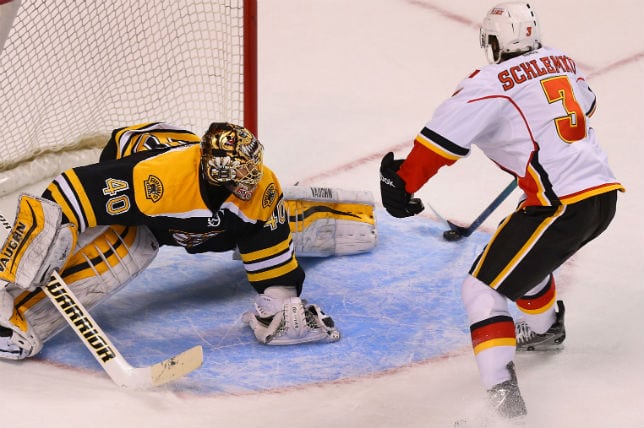
Playing 3-on-3 would reduce the chances of seeing shootout beauties such as David Schlemko's winner against Tuukka Rask, but it would also reduce the marathon shootouts we've seen this season. And the numbers show 3-on-3, and not the NHL's half measures, are the only way to do it.
Playing 3-on-3 would reduce the chances of seeing shootout beauties such as David Schlemko's winner against Tuukka Rask, but it would also reduce the marathon shootouts we've seen this season. And the numbers show 3-on-3, and not the NHL's half measures, are the only way to do it.

The next time Detroit Red Wings GM Ken Holland shows up at the GM meetings trying to convince his colleagues to change the rules governing overtime and shootouts and go to 3-on-3 hockey in extra time, he’ll have some real data to bolster his argument. And that data will tell him and everyone in the hockey world that the only way to lessen the impact of shootouts is to go to 3-on-3. It will also tell them that the customary and cautious half measures the NHL took to do a quick shovel scrape of the ice and change ends to force the long change have done almost nothing to decide games in overtime.
The much-maligned shootout still reigns supreme and it continues to be a goaltending competition instead of a scoring one. There’s no indication the NHL will ever do away with it entirely, but it seems intent on minimizing its impact as much as possible. The first measure was to make regulation and overtime wins the deciding factor in a tiebreaker, the second was to go to the long change in overtime to try to create more 4-on-4 offense and have fewer shootouts. Both measures have failed. Miserably. As you can see by the chart below, this season has produced only slightly fewer overtime games compared to the last couple of seasons. But in the 10 seasons that 4-on-4 hockey and the shootout has existed in the NHL, there have been three where there have actually been a lower percentage of shootouts than there has been this season. In fact, of the eight games that were played in the NHL last night, half of them were tied after 60 minutes and not a single one was decided in 4-on-4 overtime. All of them required shootouts. The chart below breaks down the numbers for each season the shootout has been in play in the NHL. The second column represents the number of games that were tied after 60 minutes. The third column is the number of games that needed shootouts and the fourth is the percentage of games that required shootouts to decide a winner. As you can see, the NHL’s experiment has yielded minimal positive results.
Contrast that with the American League, which took the bold move of increasing its overtime to seven minutes. The first three minutes is played 4-on-4, then it goes to 3-on-3 upon the first stoppage in play after the three-minute mark until seven minutes of overtime has expired. As you can see, the AHL has been able to dramatically reduce its number of shootouts this season, with just 49 of 206 tied games (or 23.8 percent) going to a shootout, compared to a whopping 64.7 percent last season. All told, there have been 206 games that have gone to extra time this season and 88 goals have been scored playing 4-on-4, meaning the 4-on-4 numbers in the AHL have held fairly steady, since 57.3 percent of those games would have required a shootout if not for the 3-on-3 play. Of the 118 games that have gone past 4-on-4, only 49 of them have required a shootout, which brings the percentage of those games down to just 41.5 percent. And remember, that’s with the teams playing fewer than four minutes of 3-on-3 play, depending upon how long after the three-minute mark of overtime the first stoppage in play occurred.
So if the NHL truly wants to cut down on the number of shootouts, the only thing left to decide is whether it should follow the AHL model or go straight to playing 3-on-3 for five minutes. As we’ve seen by the numbers this season, the results would be dramatic and they’d further assuage those who think the shootout is an abomination.


